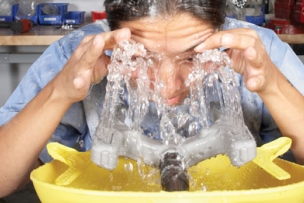MCR Safety has over forty years of experience as a leader in the field of personal protective equipment (PPE). Our assortment of offerings includes gloves, glasses, and garments which are made from the highest quality materials available to ensure maximum safety, comfort, and style.
There are 4.5 million reported injuries in the metal manufacturing industry each year in the United States alone. This does not even include the innumerable near-accidents that might have resulted in injury, had luck or quick thinking not intervened.Unguarded machinery, sharp metal, toxic chemicals and dust are just some of the hazards metalworkers face every day. Metal fabrication’s number of injuries, per 100 people, is higher than all private industry and construction.
There are dozens of different ways to become injured when working with metals. Here are the top five ways metalworkers are likely to be injured:
Material Handling Injuries
Worker’s hands are exposed to numerous hazards throughout the metal fabrication process, one of those being material handling. With over 47,000 laborers moving materials by hand in metal fabrication, gloves are definitely necessary. At some point, every machine shop worker, assembler, fabricator, and welder will have to handle materials, mostly metal.
Here are some frequent examples of material handling:
- Unloading and loading metalwork pieces can easily scrape up a worker’s hands.
- Small parts handling and metal can easily injury a metalworker’s hands, ranging from injuries to ligaments, muscles and tendons. Metals come in various forms, ranging from those that are oily to some being extremely sharp.
- There are over 130,000 sheet metal workers in the US handling large sheets of metal.
For more information on manual material handling, check out the CDC ergonomic guidelines and checklist.
Cuts and Abrasions
Bare skin is excellent at keeping infection on the outside and blood on the inside, but that only works while the skin is intact. Unfortunately, sharp metal materials, tools used in metalworking, and razor-sharp sheet metal edges will slice up a worker’s hands in a flash. There are over 130,000 sheet metal workers in the US handling large sheets of metal.
Gloves are critical, as hands and fingers are often the closest part of the body to danger. Look for an appropriate ANSI rating for cuts, abrasions, or punctures depending on the unique hazards and materials you’re working with.
Eye Injuries
There are two really sad things about eye injuries on the job. The first is how common they are: more than 2,000 eye injuries occur every day in the United States. The second is how easily preventable most of these injuries are: 90% of eye injuries could have been prevented had the person been wearing appropriate eye protection.
In the metalworking industry, eye injuries are most likely caused by flying metal fragments, projectiles, dust, and other debris kicked up by machinery. Other causes include chemical splashes and objects that fall, swing or that are pushed into the eye. Choosing safety glasses or goggles that suit the particular hazards of your environment can save you from a painful injury or even blindness.
Repetitive Strain Injuries
When we think of metalworking, it’s easy to think of more acute injuries, like serious cuts and amputations. But the most common injuries don’t occur all at once, they develop over time. Repetitive strain injuries usually affect the joints of people who repeatedly do work involving lifting, force, vibrations, and awkward positions, all of which are common in metalworking.
Examples of repetitive strain injuries include carpal tunnel syndrome, tendinitis, bursitis, and rotator cuff syndrome. While they don’t develop overnight, the pain and reduced range of motion from repetitive strain injuries can cause workers to lose time or even become permanently unable to return to their former line of work.
You can prevent repetitive strain injuries by maintaining good posture, regularly varying how you do your work, resting when needed, and by making sure you have sufficient physical conditioning to do your work with relative ease.
Burns
Exposure to hot metal is all too common for metalworkers. Machine parts, equipment, sheet metal, and metalwork pieces quickly get hot and are always a concern for metalworkers! Sheet metal is highly conductive, meaning it heats up around sources of heat.
There are over 56,000 workers assembling and fabricating in the structural metal manufacturing sub-industry. These workers move a lot of metal around job sites; often metal that has been cooking under the hot sun.
MCR Safety’s accredited ISO 17025 ITC lab tests gloves for conductive heat resistance, in accordance with the ANSI/ISEA 105:16 standard and the ASTM F1060-08 test method. This testing allows us to classify glove performance based on the contact (surface) temperature at which both the time-to-second degree burn is equal to or greater than 15 seconds, and the alarm time is greater than 4 seconds.
There are many factors for determining protection needed when handling hot objects, such as weight of the object, dexterity required, and handling time.
Other Metal Fabrication Injuries
Above are only some of the top injuries that metalworkers face. Here are a handful more to consider:
- Getting entangled in equipment and conveyor belts
- Injuries from poor machine guarding
- Injuries from power tools
Previously Featured on MCR Safety's blog.
Browse MCR's product offering on MSCDirect.com.








Talk to Us!
It was a very great informer about the things that can happen if you are not attentive to what you are doing.
60This note are explained very clear but list these injuries
86Leave a reply
Your email address will not be published. Required fields are marked *